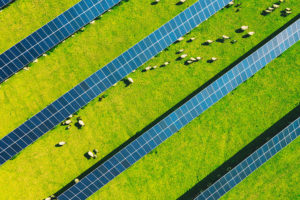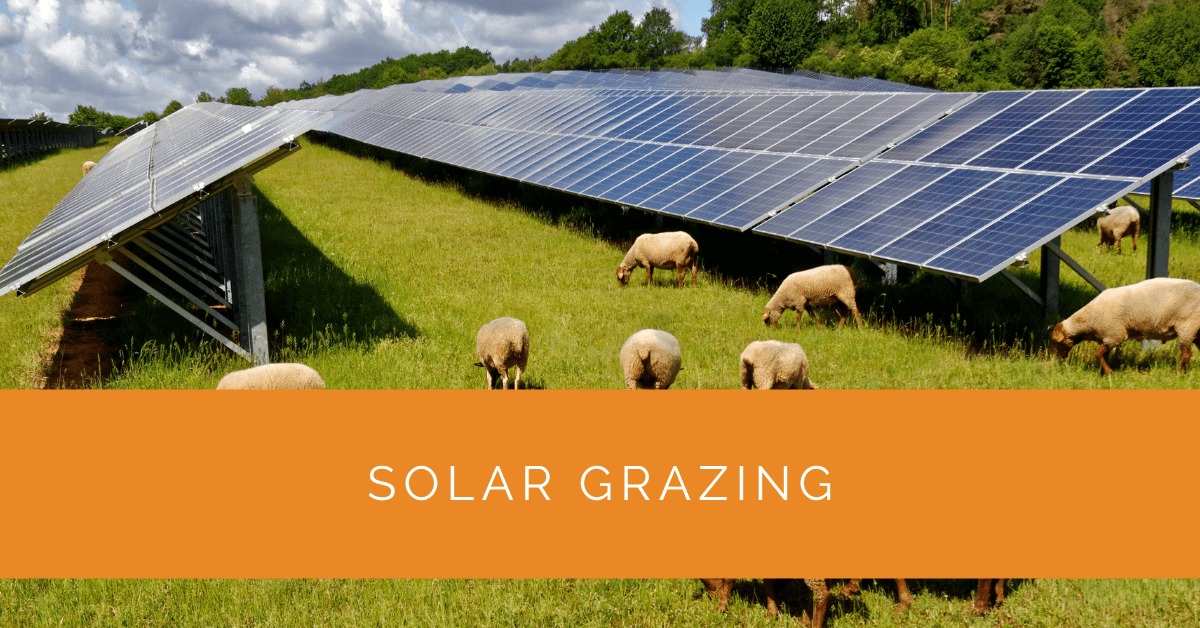Solar grazing combines renewable energy and sustainable agriculture, offering numerous benefits for farmers, solar farms, and the environment. Solar grazing offers a unique approach to vegetation management on solar farms by utilizing livestock, particularly sheep while supporting agricultural practices.
Contents
- 1 Key Takeaways
- 2 Solar Grazing: How It Works
- 3 Benefits of Solar Grazing for Farmers
- 4 Benefits of Solar Grazing for Solar Farms
- 5 Successful Implementation of Solar Grazing
- 6 Overcoming Challenges and Ensuring Success
- 7 Case Study: Implementing Solar Grazing for Sustainable Energy and Agriculture
- 8 Expert Insights From Our Solar Panel Installers About Solar Grazing
- 9 Experience Solar Excellence with Us!
- 10 Conclusion
- 11 FAQ
Key Takeaways
- Solar grazing combines renewable energy and sustainable agriculture, benefiting farmers, solar farms, and the environment.
- Solar grazing involves the controlled grazing of livestock, such as sheep, on solar farms to manage vegetation and enhance soil health.
- Successful implementation of solar grazing requires collaboration, careful planning, and adherence to best practices to ensure mutual benefits for all stakeholders involved.
Solar Grazing: How It Works
Solar grazing involves the controlled grazing of livestock, such as sheep, on solar farms. These animals play a vital role in maintaining vegetation height and density, preventing shading of solar panels. Grazing patterns are carefully managed to ensure optimal solar farm performance and animal welfare.
Benefits of Solar Grazing for Farmers
Implementing solar grazing brings several advantages to farmers:
Diversification of Income Streams
Solar grazing provides farmers with additional revenue opportunities. By leasing their land to solar farm operators, farmers can generate income from both agriculture and renewable energy production.
Reduced Vegetation Management Costs
Traditionally, solar farms rely on mechanical means, such as mowing or herbicide use, to manage vegetation. Solar grazing offers a cost-effective alternative, as sheep graze and naturally control vegetation growth, minimizing the need for expensive machinery or chemical applications.
Soil Health Improvement
Livestock grazing has positive impacts on soil health. The trampling action of grazing animals helps break down plant material, enhancing nutrient cycling and soil structure. As sheep graze, they contribute to improved soil health, promoting long-term agricultural sustainability.
Benefits of Solar Grazing for Solar Farms
Solar grazing offers various advantages to solar farm operators:
Vegetation Management
Maintaining low-growth vegetation is crucial for preventing the shading of solar panels. By introducing grazing sheep to solar farms, vegetation height is effectively controlled, ensuring optimal sunlight exposure and maximizing solar energy generation.
Fire Risk Reduction
Solar farms are susceptible to fire hazards, particularly in dry regions. Grazing animals act as natural fire mitigators by reducing fuel loads and creating firebreaks, minimizing the risk of fires spreading across solar sites.
Enhanced Biodiversity
Managed grazing on solar farms promotes biodiversity and creates habitats for various species. The presence of livestock and the diversified vegetation resulting from grazing support pollinators, birds, and other wildlife, contributing to a healthier ecosystem.

Successful Implementation of Solar Grazing
To ensure successful solar grazing initiatives, several considerations must be taken into account:
Planning Considerations for Farmers and Solar Farm Operators
Collaboration between farmers and solar farm operators is essential. Clear agreements regarding land use, animal management, and responsibilities should be established to ensure a mutually beneficial partnership.
Collaborative Partnerships
Building relationships between farmers, solar farm owners, and solar grazing experts is crucial for successfully implementing solar grazing projects. Organizations like the American Solar Grazing Association can provide guidance and support to facilitate collaboration.
Best Practices for Solar Grazing
Implementing best practices is vital for achieving optimal outcomes. This includes adopting rotational grazing systems, establishing appropriate fencing to contain livestock, and providing proper animal care and welfare.
Overcoming Challenges and Ensuring Success
While solar grazing offers significant benefits, certain challenges need to be addressed:
Predation Risks and Animal Welfare
Protecting grazing livestock from potential predation requires proper fencing and adequate shepherd or grazier supervision. Ensuring the safety and welfare of the animals is paramount to a successful solar grazing operation.
Balancing Grazing and Solar Farm Operations
Efficient coordination between grazing activities and solar farm operations is essential. Close collaboration between the grazier and solar farm operator is crucial to maintaining optimal grazing patterns without compromising solar energy production.
Collaboration, Knowledge Exchange, and Ongoing Research
Continued collaboration, knowledge exchange, and research within the solar grazing community are vital to refine best practices, address challenges, and explore new opportunities for improving solar grazing initiatives.
Case Study: Implementing Solar Grazing for Sustainable Energy and Agriculture
Background
At Solar Panels Network USA, we aim to integrate sustainable practices with cutting-edge renewable energy solutions. One of our notable projects involved implementing solar grazing on a newly established solar farm. This initiative aimed to enhance vegetation management while promoting sustainable agriculture.
Project Overview
The project was initiated on a 100-acre solar farm located in a region with a thriving agricultural community. The farm required efficient vegetation management to maintain optimal solar panel performance and prevent shading. Traditional methods of vegetation control, such as mowing and herbicide application, were both costly and environmentally impactful. Therefore, we proposed a solar grazing solution involving local farmers and their sheep to manage the vegetation naturally.
Implementation
Site Assessment and Planning
The first step was conducting a thorough site assessment to understand the terrain, vegetation types, and existing infrastructure. Collaborating with local agricultural experts and farmers, we developed a comprehensive grazing plan that included rotational grazing schedules and designated grazing areas to ensure even vegetation control.
Collaborative Partnerships
We established partnerships with local farmers who were interested in participating in the solar grazing project. These farmers provided the livestock and managed their care, while we handled the logistics of integrating grazing activities with solar farm operations. Clear agreements outlining responsibilities, grazing schedules, and compensation were put in place to ensure a smooth collaboration.
Infrastructure and Setup
Proper fencing was installed to contain the sheep within designated grazing areas and protect the solar panels from potential damage. We also set up water supply points and temporary shelters to ensure the well-being of the livestock. The solar panels were positioned at an appropriate height to allow sheep to graze underneath without hindrance.
Monitoring and Management
Throughout the grazing period, we closely monitored the vegetation and the health of the sheep. Regular inspections ensured that the grazing patterns were effective in controlling vegetation growth and that the solar panels remained unobstructed. Any adjustments needed in the grazing plan were promptly made to maintain balance between solar farm performance and livestock welfare.
Results
Efficient Vegetation Management
The introduction of solar grazing proved to be highly effective in managing vegetation across the solar farm. The sheep naturally kept the grass and other vegetation at optimal heights, preventing shading on the solar panels and maintaining their efficiency. This method significantly reduced the need for mechanical mowing and herbicide use, resulting in cost savings and environmental benefits.
Economic and Environmental Benefits
The project generated additional income for local farmers through leasing agreements and the sale of wool and meat. It also enhanced soil health due to the natural fertilization from the grazing sheep, promoting a more sustainable agricultural practice. The presence of livestock increased biodiversity, supporting local wildlife and improving the ecosystem around the solar farm.
Community Engagement and Positive Impact
The solar grazing project received positive feedback from the community, highlighting the innovative approach to combining renewable energy and sustainable agriculture. It served as a model for other solar farms in the region, encouraging broader adoption of solar grazing practices.
Summary
The solar grazing project at our 100-acre solar farm demonstrated the potential of integrating renewable energy with sustainable agricultural practices. By collaborating with local farmers and leveraging the natural grazing behavior of sheep, we achieved efficient vegetation management while promoting economic and environmental benefits. This case study exemplifies how solar grazing can create a harmonious coexistence between energy production and agriculture, contributing to a greener and more sustainable future.
Expert Insights From Our Solar Panel Installers About Solar Grazing
Solar grazing effectively integrates renewable energy and agriculture, providing a symbiotic relationship where both the environment and farmers benefit significantly.
Renewable Energy Specialist
Managing vegetation with livestock like sheep offers a sustainable and cost-efficient alternative to traditional methods, reducing the need for mechanical mowing or herbicides.
Solar Installation Engineer
Solar grazing not only helps maintain optimal solar panel performance but also promotes biodiversity, creating a healthier ecosystem around solar farms.
Senior Solar Project Manager
Experience Solar Excellence with Us!
Trust in Solar Panels Network USA, where our seasoned experts deliver top-quality solar solutions for homes and businesses nationwide. With a legacy of countless successful installations and a commitment to sustainable energy, we’re your reliable partner in the solar journey. Ready for a brighter, eco-friendly future? Call us now at (855) 427-0058 and harness the power of the sun!
Conclusion
Solar grazing presents a promising convergence of renewable energy and sustainable agriculture. By leveraging the natural behavior of livestock, solar farms can benefit from cost-effective vegetation management while farmers diversify their income streams. With careful planning, collaborative partnerships, and adherence to best practices, solar grazing contributes to a regenerative food-energy system, highlighting the potential for a harmonious coexistence between agriculture and renewable energy production.
FAQ
Can you graze cattle on a solar farm?
Cattle grazing on a solar farm is generally not recommended due to their larger size and potential for causing damage to the solar panels. Smaller livestock, such as sheep and goats, are more commonly used for solar grazing.
What animals graze in solar panels?
Sheep and goats are the most commonly used animals for solar grazing. Their smaller size, gentle grazing behavior, and ability to navigate around solar panels make them well-suited.
What are the benefits of solar grazing?
Solar grazing offers several benefits, including:
- Cost-effective vegetation management on solar farms, reducing the need for mechanical maintenance.
- It improved soil health through natural fertilization and nutrient cycling by grazing animals.
- It enhanced biodiversity and ecological benefits, creating habitats for pollinators and supporting a thriving ecosystem within the solar site.
About the Author
Solar Panels Network USA stands at the forefront of solar energy solutions, driven by a team of seasoned solar engineers and energy consultants. With over decades of experience in delivering high-quality solar installations and maintenance, we are committed to promoting sustainable energy through customer-centric, tailored solutions. Our articles reflect this commitment, crafted collaboratively by experts to provide accurate, up-to-date insights into solar technology, ensuring our readers are well-informed and empowered in their solar energy decisions.

